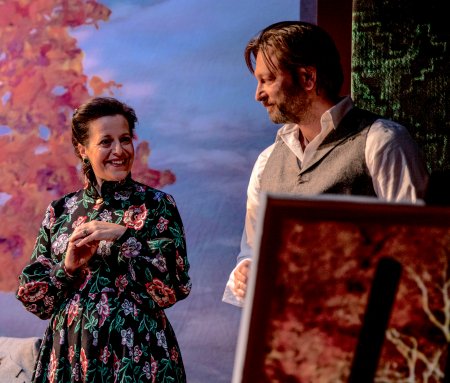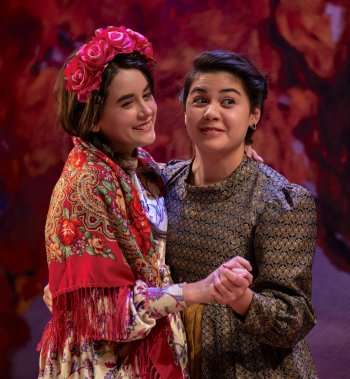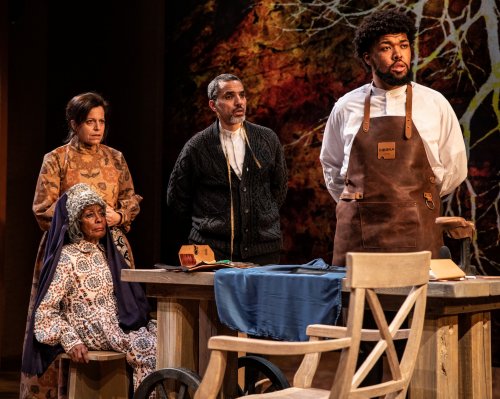Chekhov/Tolstoy: Love Stories
Mint Theater Company’s latest is an American premiere of an intriguing double bill adapted from Russian short stories by two masters of the form.

Katie Firth and Alexander Sokovikov in a scene from Miles Malleson’s “The Artist,” part of “Chekhov/Tolstoy: Love Stories” at the Mint Theater Company (Photo credit: Maria Baranova)
[avatar user=”Victor Gluck” size=”96″ align=”left”] Victor Gluck, Editor-in-Chief[/avatar]
The Mint Theater Company has rediscovered and championed British actor/playwright Miles Malleson with Conflict and Yours Unfaithfully. Now they have combined two of his one acts adapted from great short story writers in an evening called Chekhov/Tolstoy: Love Stories in their premiere pairing. While the production directed by Jonathan Bank and Jane Shaw (each directing one play) is able to be performed on basically the same set, the two plays have little to do with each other and represent love in two different ways. Anton Chekhov and Leo Tolstoy are major writers, but the adaptations appear to be minor and do not show off their authors at their best. Although the Chekhov story is basically an anecdote, the Tolstoy tale is a fable with a message.
In Malleson’s adaptation of Chekhov’s “An Artist’s Story” here named simply “The Artist,” the playwright has reduced the locales to a single one, the garden of a Russian country house in the autumn of the turn of the last century. Nicov, a Moscow landscape painter, who has been idling away the last five weeks on a country vacation, is engaged in painting a scene from the Barishchnya garden, while the younger daughter, 18-year-old Genya reads a book nearby. It becomes obvious that the intellectual and romantic Genya is fascinated by Nicov who is twice her age and much more worldly. He seems equally inspired by her attention.

Anna Lentz and Brittany Anikka Liu in a scene from Miles Malleson’s “The Artist,” part of “Chekhov/Tolstoy: Love Stories” at the Mint Theater Company (Photo credit: Maria Baranova)
When his landlord, the landowner Bylekurov, Genya’s mother and her older sister, the 23-year-old Lidia appear, the conversation becomes general. We have previously been told that Lidia is one of those people who is constantly doing good deeds: teaching at the village school, distributing books at the library, running a medical dispensary out of her mother’s house, running a relief committee for the victims of a recent fire. Unfortunately, it is obvious that there is an antagonism between Lidia and Nicov. Lidia mocks Nicov for being a useless member of society, while he retaliates that real change is needed to alleviate the hard lives of the poor, not dealing simply with the outer symptoms of their distress. When left alone, Nicov and Genya declare their love for one another. However, the next morning ironically things change drastically.
Aside from the fact that there is not much plot, Bank has cast actors who have very different styles. In what is basically a comedy of manners, Alexander Sokovikov as Nicov is heavy and stolid, while the play needs a lighter touch. Anna Lentz’s Genya has charm but she is not given enough to say to let us know much about her. As her vigorous sister, Brittany Anikka Liu does not suggest the dogmatic do-gooder she is meant to be. Katie Firth is gracious as the girl’s mother but J. Paul Nicholas’ Bylekurov gives an ambiguous performance, not coming up to Nicov’s description of him as boring and argumentative.

Vinie Burrows, Katie Firth, J. Paul Nicholas and Malik Reed in a scene from Miles Malleson’s “Michael,” part of “Chekhov/Tolstoy: Love Stories” at the Mint Theater Company (Photo credit: Maria Baranova)
Jane Shaw’s production of “Michael,” from Tolstoy’s “What Men Live By,” has the light touch this folk tale needs, making an impressive directing debut. Covering two years in the lives of a poor shoemaker and his wife, the story dramatizes Tolstoy’s deep faith and belief in the meaning of life. The story concerns Simon, who having gone to collect money owed to him in order to buy a sheepskin coat for the winter, is unable to collect and he returns home without this clothing he desperately needs. However, with him on his return is a naked stranger wrapped in his old ragged coat. His wife Matryona is at first spiteful against the stranger Michael but takes pity on him and feeds and clothes him when she sees his humility. In the course of time, Michael becomes an expert craftsman through Simon’s teaching. In the course of the next two years, events occur that awe the shoemaker and his wife and from which they (and we) learn three messages: what dwells in man, what is not given to man, and what men live by. Ultimately, the final message is love.
The cast is made up of the same five actors from the first play plus two additional ones. The family of the shoemaker is underplayed with deft care by Nicholas and Firth with the addition of legendary actress Vinie Burrows as the servant Aniuska who in this telling appears to be rather simple. Michael, the nearly silent stranger, is played by Malik Reed with tremendous simplicity. Sokovikov appears as a Russian nobleman who unaccountably breaks into Russian at one point in his request for boots to last a year, though no one else speaks anything but English in the play. Lentz as his proud servant and Liu as a woman customer who has taken in two orphaned children demonstrate their versatility from their characters in the earlier play.

Malik Reed and Alexander Sokovikov in a scene from Miles Malleson’s “Michael,” part of “Chekhov/Tolstoy: Love Stories” at the Mint Theater Company (Photo credit: Maria Baranova)
The themes of the two plays appear to be that of living with love and in a world without love. The two sets by Roger Hanna include the reverse images of each other: “The Artist” includes a huge tree covered with red autumn leaves, while the interior of the shoemaker’s cottage depicts the roots of this same tree on its back wall. The design does not really work until we see that of the second play when the concept becomes clear. While Oana Botez’s costumes for these Russians from one hundred years ago may be completely accurate, the material for the women’s print dresses are both busy and distracting, while those of the men are more in keeping with what we have come to expect in Russian plays. The lighting by Matthew Richards is subtle and unobtrusive; however, the special effects of lighting needed in the second play seem to fall short of their goal. Aside from her directing assignment, Shaw is also responsible for the appropriate original music and sound design.
As produced by the Mint Theater Company, Chekhov/Tolstoy: Love Stories is pleasant enough. However, from these two master writers one expects something more filling rather than just a meal made up of hors d’oeuvres. The evening may leave you feeling hungry and unfulfilled rather than totally satisfied.
Chekhov/Tolstoy: Love Stories (through March 11, 2020)
Mint Theater Company
Theater Row Theaters, 410 W. 42nd Street, in Manhattan
For tickets, call 212-239-6200 or visit http://www.Telecharge.com
Running time: one hour and 30 minutes without an intermission






Leave a comment